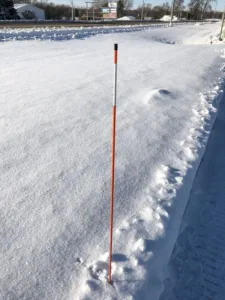Introduction
Snow poles play a critical role in ensuring safety and navigation in snow-covered landscapes. Whether marking the boundaries of a road, guiding snowplow drivers, or identifying hazards, the choice between fiberglass and traditional materials for snow poles can significantly impact their effectiveness, durability, and overall cost-efficiency. This article provides an in-depth comparison of fiberglass versus traditional snow poles, highlighting their features, benefits, and drawbacks to help you make an informed decision.

fiberglass snow poles
Understanding Snow Poles
Definition and Purpose
Snow poles, or snow stakes, are tall markers installed alongside roads, in parking lots, and around key infrastructure to indicate boundaries and obstacles when the ground is covered in snow. Their primary purpose is to guide vehicles and pedestrians, preventing accidents and ensuring smooth navigation through snowy terrains.
Materials Used in Manufacturing
Traditionally, snow poles have been made from materials like wood, metal, and in recent years, fiberglass. Each material offers different attributes in terms of visibility, durability, and flexibility under snow load.
Significance in Snowy Regions
In regions where snowfall is significant and frequent, snow poles are indispensable. They aid in the efficient clearing of snow and minimize the risk of vehicular and pedestrian accidents by marking safe paths.
Fiberglass Snow Poles
Features and Benefits
Fiberglass snow poles are known for their high visibility, flexibility, and resistance to corrosion. Their reflective properties enhance safety by improving visibility during snowstorms and at night.
Durability and Maintenance
One of the most significant advantages of fiberglass snow poles is their durability. Resistant to rust, decay, and bending, they require minimal maintenance, making them a cost-effective option in the long run.
Installation Process
The installation of fiberglass snow poles is straightforward, often involving simple ground insertion or mounting on existing structures. Their lightweight nature simplifies handling and installation processes.
Traditional Snow Poles
Composition and Characteristics
Traditional snow poles are typically made from wood or metal, each offering unique benefits. Wood poles are cost-effective and easy to install, while metal poles offer strength and longevity.
Lifespan and Care
The lifespan of traditional snow poles varies with material and environmental conditions. Regular maintenance, such as painting or rust protection, may be necessary to extend their life.
Installation Techniques
Installing traditional snow poles can be more labor-intensive, especially for metal poles that require drilling and securing to withstand harsh weather conditions.
Comparative Analysis
Strength and Durability
Comparing the strength and durability of fiberglass and traditional snow poles reveals that fiberglass often outperforms in flexibility and longevity, especially in areas with severe weather.
Cost-Efficiency
While the initial cost of fiberglass snow poles may be higher, their durability and low maintenance requirements can result in long-term savings compared to traditional options.
Environmental Impact
Fiberglass snow poles have a lower environmental impact due to their longevity and reduced need for replacement. However, considerations around recyclability and production energy must be taken into account.
Pros and Cons
Advantages of Fiberglass Snow Poles
Fiberglass poles offer numerous benefits, including enhanced safety features, minimal maintenance, and resistance to environmental factors.
Disadvantages of Fiberglass Snow Poles
The primary disadvantage of fiberglass snow poles is their higher initial cost and the need for careful handling during installation to prevent splintering.
Comparing with Traditional Alternatives
When compared with traditional materials, fiberglass offers a compelling array of benefits, though the choice may ultimately depend on specific project requirements and budget constraints.
Installation and Maintenance
Installation Guidelines
Proper installation is crucial for the effectiveness of snow poles. Following manufacturer guidelines ensures that poles are correctly positioned and secured.
Maintenance Tips
Regular inspections and minor repairs can significantly extend the life of snow poles. For fiberglass poles, checking for UV damage and wear is essential.
Repair and Replacement
Understanding when to repair or replace snow poles can save time and resources. Fiberglass poles often offer easier repair options compared to traditional materials.
Cost Analysis
Initial Investment
The cost comparison between fiberglass and traditional snow poles should consider the purchase price, installation expenses, and any additional equipment required.
Long-Term Savings
Fiberglass snow poles can offer greater long-term savings due to their durability and reduced need for replacement and maintenance.
Comparison with Traditional Snow Poles
A detailed cost analysis will reveal that while the upfront cost of fiberglass poles may be higher, their extended lifespan and minimal maintenance requirements provide a cost-effective solution over time.
Environmental Considerations
Sustainability of Materials
Evaluating the sustainability of materials used in snow poles is essential. Fiberglass poles, while durable, raise questions about recyclability and environmental impact during production.
Recycling and Disposal
The end-of-life disposal of fiberglass snow poles requires consideration of environmental best practices and potential recycling options.
Impact on Ecosystems
Assessing the impact of snow pole materials on local ecosystems is crucial, especially in sensitive or protected areas.
User Experiences
Case Studies
Exploring case studies where different types of snow poles have been used can provide insights into their real-world performance and user satisfaction.
Expert Opinions
Seeking opinions from industry experts can help in understanding the advantages and limitations of fiberglass versus traditional snow poles.
Consumer Feedback
Consumer feedback offers valuable perspectives on the practicality, durability, and overall satisfaction with different snow pole materials.
Choosing the Right Option for You
Factors to Consider
When selecting snow poles, consider factors such as climate, terrain, visibility needs, and budget to ensure the best fit for your requirements.
Recommendations by Experts
Expert recommendations can guide the selection process, offering advice based on experience and industry standards.
Personal Preferences
Ultimately, personal preferences and specific project needs will influence the choice between fiberglass and traditional snow poles.
Conclusion
Concluding the comparison between fiberglass and traditional snow poles, this section will summarize the key points discussed, reiterating the importance of selecting the right material for effective, efficient, and safe snow management.
 info@unicomposite.com
info@unicomposite.com


























